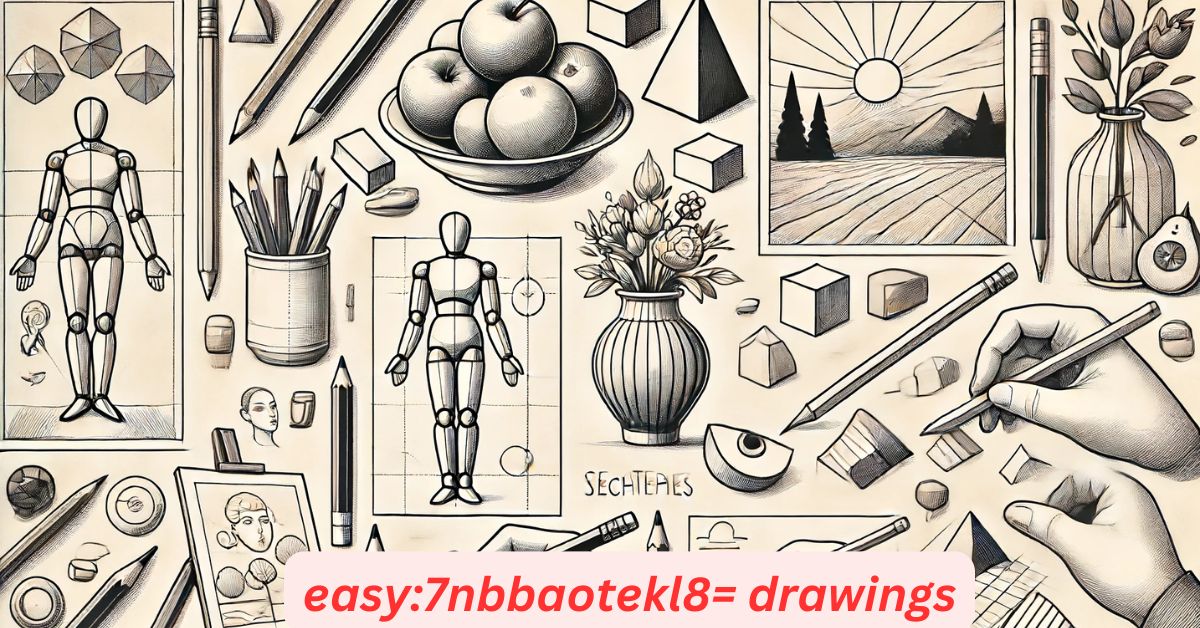Easy drawings are simple sketches that focus on basic shapes and lines. They are great for beginners to practice and improve their art skills without feeling overwhelmed.
Unlock your inner artist with easy drawings that anyone can master! Start with simple shapes and watch your creativity flow effortlessly.
Easy drawings are perfect for those looking to start their art journey. With just a few basic shapes and techniques, you can create impressive sketches in no time.
Materials You Need
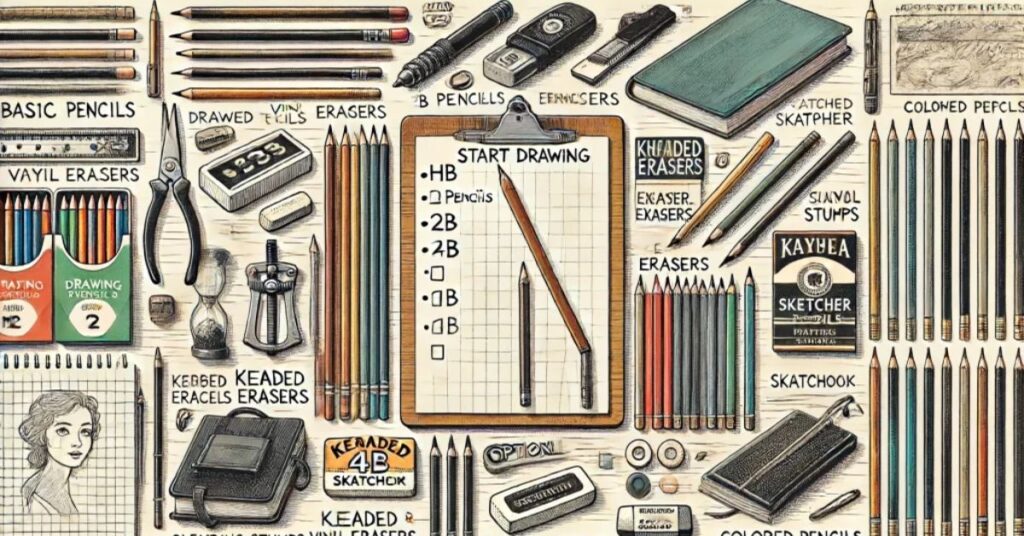
For easy drawings, gather basic materials like pencils, erasers, and paper. You can also use colored pencils or markers for added flair. A sketchbook is great for practice and keeping all your work in one place. Start with simple tools to build your skills.
Basic Drawing Tools
To begin easy:7nbbaotekl8= drawings, you’ll need some essential tools:
- Pencils: HB for light lines, 2B for darker strokes
- Eraser: A soft eraser for easy corrections
- Paper: Smooth drawing paper or sketchbook
- Sharpener: To keep pencils pointed
Recommended Brands
Some reliable brands for beginners include:
- Pencils: Faber-Castell, Staedtler
- Erasers: Tombow, Staedtler
- Paper: Strathmore, Canson
Optional Tools For Enhancement
As you progress, consider adding:
- Blending stumps for smooth shading
- Colored pencils for adding color
- Drawing pens for fine details
Getting Started With Easy:7nbbaotekl8= Drawings
Begin by selecting a simple subject to draw, such as a flower or a basic shape. Focus on observing the details and practicing basic strokes. Draw lightly at first to make changes easily. This approach helps you build confidence in your drawing.
Choosing Your Subject
Start with simple objects. A cup, an apple, or a leaf are good choices. These subjects have basic shapes. They’re easy to find and draw. Begin with objects you see daily.
Setting Up Your Workspace
Create a comfortable space to draw. Ensure good lighting. Have a flat surface to work on. Keep your materials within reach. A clean, organized space helps focus.
Basic Drawing Warm-Ups
Begin with simple exercises. Draw straight lines. Practice circles and curves. These warm-ups improve hand-eye coordination. Spend a few minutes on warm-ups before each drawing session.
Understanding Lines And Shapes
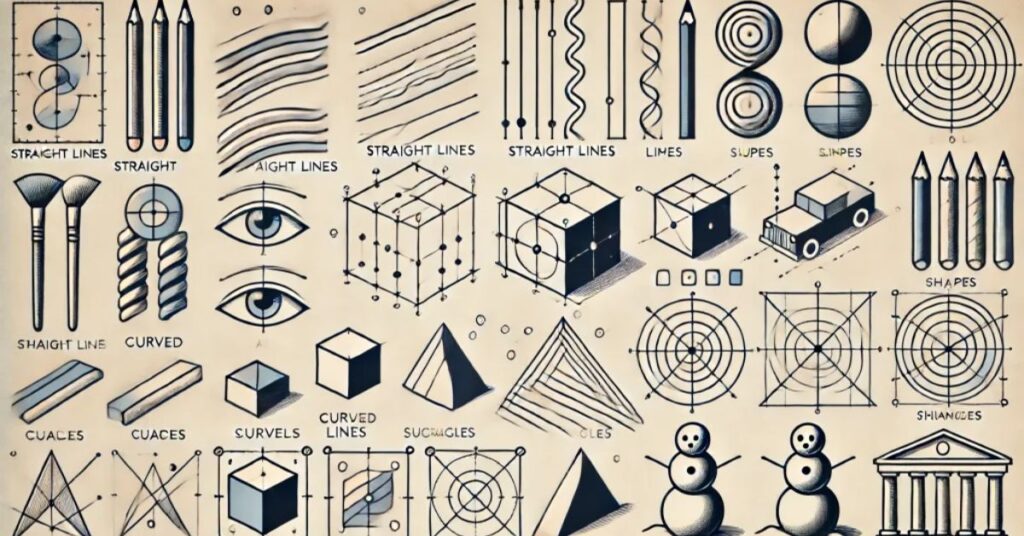
Begin by selecting a simple subject to draw, such as a flower or a basic shape. Focus on observing the details and practicing basic strokes. Draw lightly at first to make changes easily. This approach helps you build confidence in your drawing.
Importance Of Lines
Lines are the building blocks of drawings. Practice different types:
- Straight lines
- Curved lines
- Zigzag lines
Experiment with line weight and pressure. Vary your lines to create interest in your drawings.
Basic Geometric Shapes
Master these fundamental shapes:
- Circles
- Squares
- Triangles
- Rectangles
Practice drawing these shapes in various sizes. Combine them to create more complex forms.
Combining Shapes To Form Objects
Learn to see objects as combinations of shapes. A house is a square with a triangle on top. A tree is a circle on a rectangle. Break down complex objects into simpler shapes.
Shading Techniques
Shading adds depth and dimension to your drawings. Practice using light and dark tones to create contrast. Use techniques like hatching, cross-hatching, and blending. Shading helps your drawing look more realistic and dynamic.
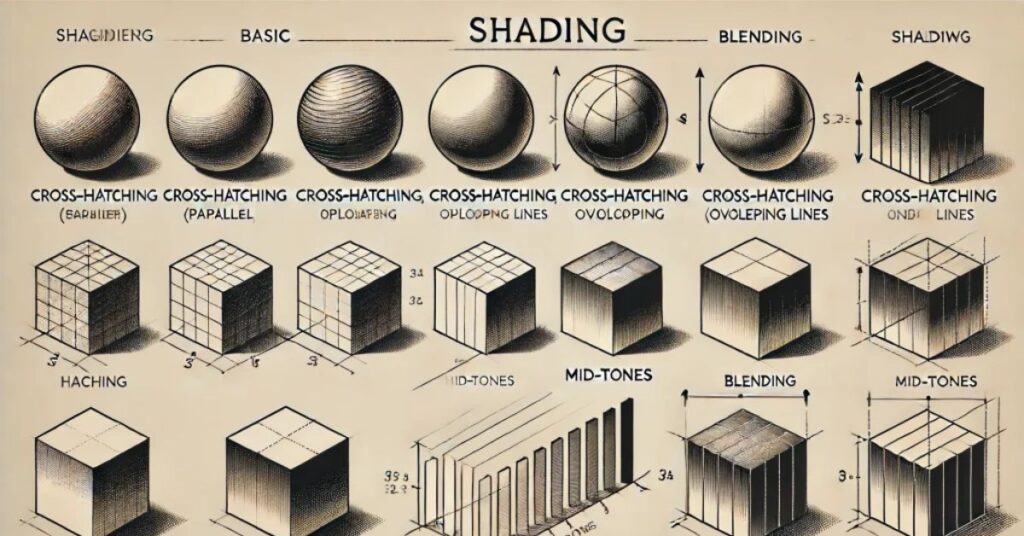
Basics Of Shading
Shading adds depth and dimension. Start with simple techniques:
- Hatching (parallel lines)
- Cross-hatching (overlapping lines)
- Stippling (dots)
Practice these techniques to create different textures and tones.
Light And Shadow
Understand how light affects objects. Identify the light source. Shade accordingly. Lighter areas face the light. Darker areas are in shadow. Observe how light interacts with objects around you.
Gradient And Blending
Practice creating smooth transitions. Use varying pressure on your pencil. Blend shades with a finger or blending stump. Gradients add realism and depth to your drawings.
Read This Blog: Baby:be3sdxjthbc= Dog
Perspective Drawing
Perspective is key to creating a sense of depth in your drawings. Start with a simple one-point perspective to understand how objects appear closer or farther away. This technique helps make your artwork look more 3-dimensional.
One-Point Perspective
Learn to create depth in drawings. All lines converge to a single point. This technique is great for roads or hallways. Practice drawing boxes and buildings using one-point perspective.
Two-Point Perspective
Use two vanishing points on the horizon. This is useful for drawing buildings or rooms. It creates a more realistic 3D effect. Start with simple cubes before moving to complex structures.
Creating Depth In Your Drawings
Use these techniques for depth:
- Overlapping objects
- Size variation
- Detail reduction in distant objects
Apply these principles to make your drawings appear more three-dimensional.
Drawing Still Life
Still life drawing involves sketching everyday objects like fruits or vases. It helps in understanding shape, proportion, and light. Focus on capturing details and shadows to bring the objects to life. It’s a great way to practice your observational skills.
Setting Up A Still Life Scene
Arrange simple objects for practice. Use fruits, vases, or books. Create interesting compositions. Consider lighting and shadows. Start with two or three objects and gradually increase complexity.
Observing And Sketching
Observe objects carefully. Start with basic shapes. Focus on proportions. Pay attention to negative space between objects. Take your time to study the scene before drawing.
Adding Details
Once basic shapes are in place, add details. Include textures, patterns, and fine lines. This brings your drawing to life. Don’t rush this stage; build up details gradually.
Figure Drawing
Figure drawing is about capturing the human form. Start with simple poses and focus on basic anatomy.
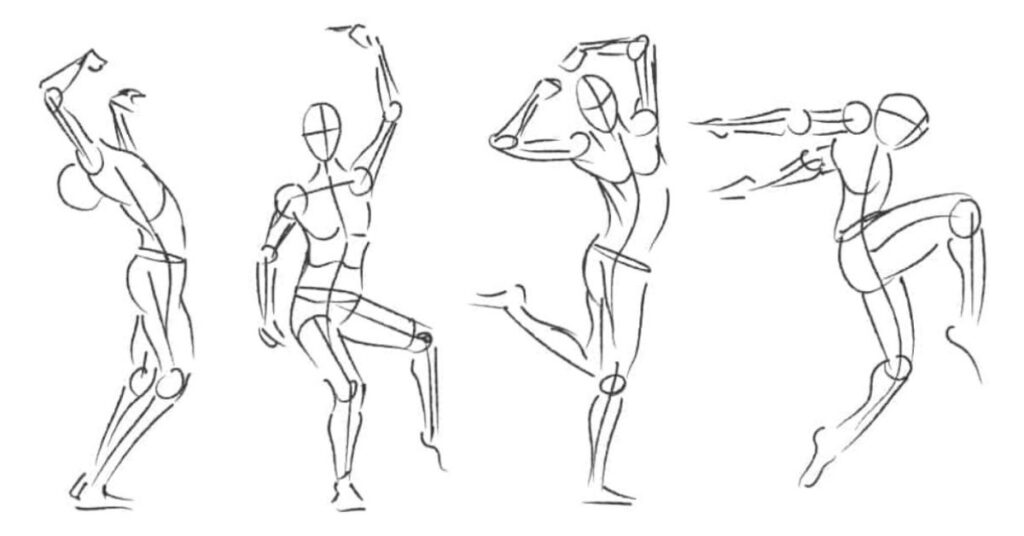
Use gesture drawing to quickly capture the movement and flow of a pose. This practice improves your understanding of proportions and body dynamics.
Basic Human Anatomy
Learn basic body proportions. Understand the skeleton structure. Practice drawing simple stick figures first. Study the relationships between different body parts.
Proportions And Gestures
Study human proportions. The average body is about 7-8 heads tall. Practice quick gesture drawings to capture movement. Focus on the overall form before adding details.
Drawing Dynamic Poses
Experiment with different poses. Draw figures in action. Pay attention to weight distribution and balance. Use reference photos or live models for practice.
Drawing Nature
Drawing nature can include trees, flowers, and landscapes. Focus on the details and textures you see in leaves, bark, or water. Nature drawing enhances your observation skills and teaches you how to capture natural beauty.
Trees And Plants
Start with basic tree shapes. Add branches and leaves. Practice different types of trees. Draw various leaf shapes. Observe trees in your environment for inspiration.
Animals
Begin with simple animal shapes. Add details gradually. Focus on characteristic features like fur or feathers. Study animal anatomy to improve your drawings.
Landscapes
Start with a horizon line. Add elements like mountains, trees, and water. Use perspective to create depth in your landscapes. Practice both rural and urban landscapes.
Digital Drawing
Digital drawing uses tools like graphic tablets and software. Start with free apps to practice the basics.

Digital art allows you to experiment with colors, layers, and tools without wasting materials. It’s perfect for those who love both art and technology.
Introduction To Digital Tools
Explore digital drawing with a graphics tablet. Learn to use a stylus. Familiarize yourself with drawing software. Start with basic tools before exploring advanced features.
Software Recommendations
Try beginner-friendly software:
- Krita (free)
- Autodesk Sketchbook (free)
- Procreate (paid, for iPad)
Experiment with different software to find what suits you best.
Basic Digital Techniques
Learn to use layers. Experiment with different brushes. Practice blending and shading digitally. Take advantage of undo and redo functions to experiment freely.
Common Mistakes And How To Avoid Them?
Avoid pressing too hard with your pencil; keep strokes light to make adjustments easily. Don’t skip practicing basic shapes—they’re crucial for good art. Consistently review your work and learn from your mistakes to improve.
Overworking A Drawing
Avoid adding too many details. Know when to stop. Step back and assess your work regularly. Learn to appreciate simplicity in your drawings.
Proportional Errors
Check proportions frequently. Compare sizes of different elements. Use guidelines to maintain correct proportions. Practice measuring with your pencil.
Ignoring Light Sources
Always consider the light source. Be consistent with shadows and highlights. This adds realism to your drawings. Study how light behaves in different environments.
Read This Blog: Banana:b4hnuk08dew= Monkey: A Sweet Bond Between Fruit and Animal
Tips For Continuous Improvement
Draw regularly to build your skills and confidence. Study other artists and try new techniques. Keep a sketchbook for daily practice. Review your progress often to see how much you’ve grown and where you can still improve.
Practicing Regularly
Draw every day, even if just for a few minutes. Consistency is key to improvement. Set a regular time for drawing practice.
Seeking Feedback
Share your work with others. Ask for constructive criticism. Learn from feedback to grow as an artist. Join art groups or online communities for support.
Learning From Others
Study the work of other artists. Analyze their techniques. Try to incorporate new methods into your drawings. Visit art galleries and exhibitions for inspiration.
Incorporating Creativity

Add your personal touch by mixing styles or combining different elements. Experiment with colors, patterns, and textures. Let your imagination guide you to create unique and expressive drawings that reflect your personality.
Finding Inspiration
Look for inspiration everywhere. Nature, books, and daily life can spark ideas. Keep a sketchbook for quick ideas. Take photos of interesting subjects for later reference.
Experimenting With Styles
Try different drawing styles. Experiment with realistic, cartoon, or abstract approaches. Find what you enjoy most. Don’t be afraid to mix styles and create something unique.
Developing Your Unique Voice
As you practice, you’ll develop your personal style. Embrace your unique approach to drawing. Let your personality shine through your artwork.
Resources For Learning
Use online tutorials, books, and art classes to enhance your skills. Websites like YouTube and Skillshare offer many resources. Joining art communities can provide feedback and inspiration. Stay open to learning from varied sources.
Books And Online Courses
Explore drawing books for beginners. Try online courses on platforms like Udemy or Skillshare. Look for courses that match your interests and skill level.
Drawing Communities
Join online art communities. Share your work on platforms like DeviantArt or Instagram. Engage with other artists. Participate in art challenges and collaborations.
YouTube Channels And Tutorials
Follow drawing tutorials on YouTube. Channels like Proko and DrawingWiffWaffles offer great tips. Watch time-lapse videos of artists creating their work.
Frequently Asked Questions
How often should I practice drawing?
Try to draw daily, even if just for 15-30 minutes. Consistency is key to improvement.
What’s the best paper for beginners?
A standard sketchbook with medium-weight paper is great for beginners. It’s versatile and affordable.
Can I learn drawing without taking classes?
Yes, you can learn through self-study. Use online resources, books, and practice regularly.
How long does it take to get good at drawing?
Improvement is ongoing, but you’ll see noticeable progress within a few months of regular practice.
Is digital drawing easier than traditional drawing?
Digital drawing offers more tools and flexibility, but the fundamental skills are the same as traditional drawing.
Conclusion
Easy:7nbbaotekl8= drawings are an excellent way to start your artistic journey. With practice and patience, you’ll see improvement. Remember, every artist started as a beginner.
Enjoy the process of learning and creating. Don’t be discouraged by initial challenges; persistence is key to success in drawing. Keep exploring, experimenting, and most importantly, have fun with your art.

Marcus Delgado is a certified financial planner with expertise in retirement strategies and tax optimization.
With a background in economics and a passion for helping individuals achieve financial freedom, Marcus provides practical advice on long-term wealth building and smart money management.
